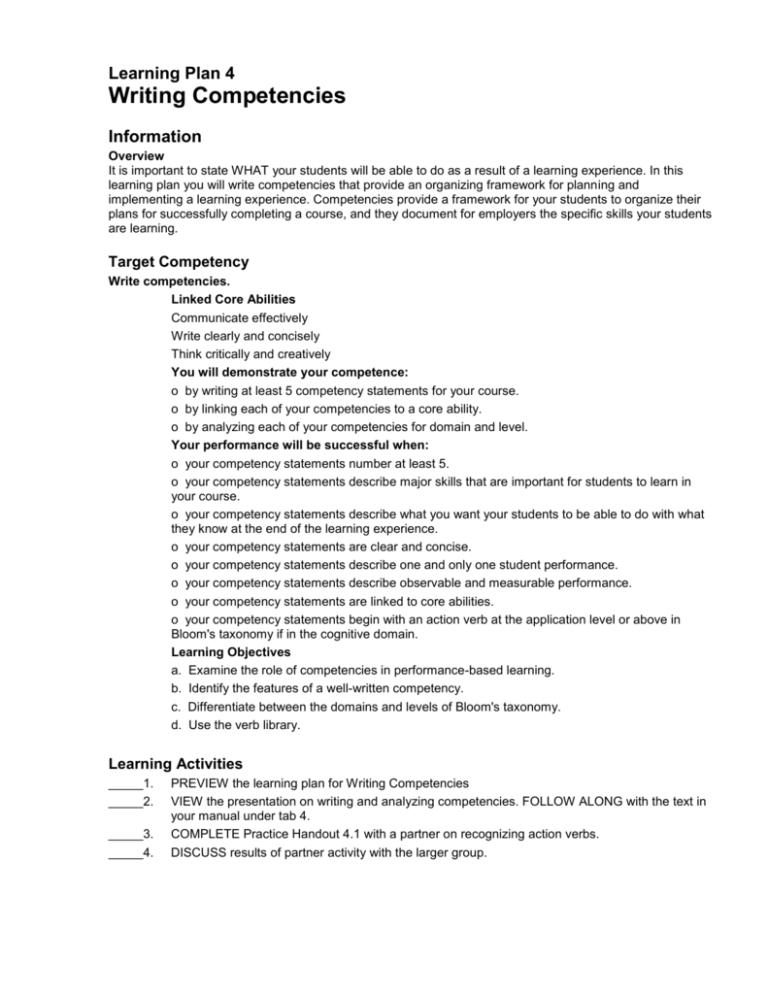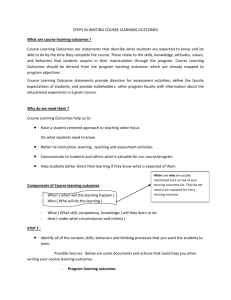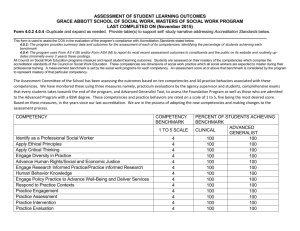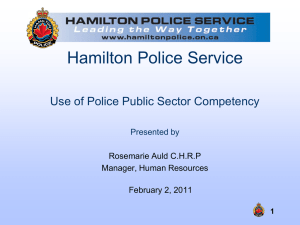Learning Plan 4 Writing Competencies Information Overview It is
advertisement

Learning Plan 4 Writing Competencies Information Overview It is important to state WHAT your students will be able to do as a result of a learning experience. In this learning plan you will write competencies that provide an organizing framework for planning and implementing a learning experience. Competencies provide a framework for your students to organize their plans for successfully completing a course, and they document for employers the specific skills your students are learning. Target Competency Write competencies. Linked Core Abilities Communicate effectively Write clearly and concisely Think critically and creatively You will demonstrate your competence: o by writing at least 5 competency statements for your course. o by linking each of your competencies to a core ability. o by analyzing each of your competencies for domain and level. Your performance will be successful when: o your competency statements number at least 5. o your competency statements describe major skills that are important for students to learn in your course. o your competency statements describe what you want your students to be able to do with what they know at the end of the learning experience. o your competency statements are clear and concise. o your competency statements describe one and only one student performance. o your competency statements describe observable and measurable performance. o your competency statements are linked to core abilities. o your competency statements begin with an action verb at the application level or above in Bloom's taxonomy if in the cognitive domain. Learning Objectives a. Examine the role of competencies in performance-based learning. b. Identify the features of a well-written competency. c. Differentiate between the domains and levels of Bloom's taxonomy. d. Use the verb library. Learning Activities _____1. _____2. _____3. _____4. PREVIEW the learning plan for Writing Competencies VIEW the presentation on writing and analyzing competencies. FOLLOW ALONG with the text in your manual under tab 4. COMPLETE Practice Handout 4.1 with a partner on recognizing action verbs. DISCUSS results of partner activity with the larger group. _____5. _____6. _____7. COMPLETE Practice Handout 4.2 by yourself on recognizing effective competencies. REVIEW your work on Practice Handout 4.2 through large group discussion. PARTICIPATE in group activity to develop competencies for the Tent Camping Basics course at the School of Outdoor Living. _____8. VIEW the presentation on Bloom's taxonomy. FOLLOW ALONG with the text in your manual under tab 4. _____9. COMPLETE Practice Handout 4.3 on recognizing domains. _____10. COMPLETE Practice Handouts 4.4, 4.5, and 4.6 on analyzing level within each domain. _____11. REVIEW your work with the larger group. Assessment Activities _____1. _____2. WRITE at least 5 competencies for your course. Use Assessment Sheet 4.1. ANALYZE your competencies by level and domain of Bloom's taxonomy. Competencies *What are competencies? Competencies are the intended outcomes of the instruction you are providing. They describe the technical skills being taught in terms of actual performance. They tell the student what it is that they will be able to DO upon successful completion of the training. Competencies are like blueprints for curriculum construction. Competencies… Blueprints… …address customer needs …address customer needs …are based on a broader goal …are based on a broader purpose …determine what will be learned …determine what will be built …reflect outside specifications …reflect outside specifications …have a standard format …have a standard format …meet expectations …meet building code expectations …establish criteria for a product / process …establish tolerances for a finished product …require interpretation …require interpretation …give direction for teaching methods …give direction for building methods …drive selection / design of materials / equipment …drive selection of materials / tools / equipment *Where do competencies come from? Competencies are derived from the external standards identified for your industry, or from an analysis of the duties and tasks required for your occupation, or a combination of the two. Competencies describe the actions required for a person to satisfy the standard, or to perform the duties and tasks identified. Competencies are comprised of knowledge, skills, and attitudes. The competency itself is the combination of those three things—KSA’s—and describe whole actions. There are seven characteristics of a good competency: 1. Competency describes the performance of a major skill. CONDUCT a client consultation. 2. Competency statement begins with an action verb, describing what the student will be able to do. a. Action verbs require DOING (create, draw, explain) b. Non-action verbs describe internal or abstract states of being (know, understand, be aware of) **CONDUCT is doing, versus knowing what the parts are, or understanding how they go together. It’s not enough to know and understand, you have to be able to DO. 3. Competencies must be observable and measurable. OBSERVABLE: You must be able to see a product, process / procedure, or both. NOT OBSERVABLE: KNOW the muscles of the face. MEASURABLE: You must be able to measure the quality of the product or process / procedure. NOT MEASURABLE: Understand professional hygiene. 4. Competency is clear, concise, and precise, describing action. 5. Competency specifies a single performance / outcome, not multiple performances. WRONG: ANALYZE hair and select the correct chemical product. 6. Competency describes an intended outcome, not the learning process WRONG: Read chapter on testing methodology. 7. Competency describes the student’s performance, not the instructor’s activities, learning plans, or instructional strategies. WRONG: Take and pass a quiz on Oregon health laws. Bloom’s Taxonomy Benjamin Bloom was an academic in the field of education who came up with this taxonomy as a tool for instructional design. It describes different domains of learning, and within each domain, different levels that describe the process by which learning takes place. There are three domains within the taxonomy: Cognitive, Psychomotor, and Affective. Within the cognitive domain, there are six levels: know, comprehend, apply, analyze, synthesize, and evaluate. Here is a graphical representation of the cognitive domain of Bloom’s taxonomy: Learning begins on the bottom step, with each step up representing a higher level of thinking. You can tell your students exactly what level of thinking is required of them by using precise verbs. Competencies are about DOING, not about simply knowing. Be sure to state your competencies beginning with a verb that corresponds to a level that is above the comprehension level, as illustrated by the dotted line below. EVALUATE I can tell information back, explain it, give examples, apply it, take it apart, analyze it, put it together with other things to produce new things, AND judge the value and quality of the new creation. I can determine the utility and quality of the outcome of actions. I can engage in personal reflection about the things I’ve learned and how I’ve interacted with those things. SYNTHESIZE I can tell information back, explain it, give examples, apply it, take it apart and examine it, AND put it together with other things to produce something new. I can now create something entirely new and my own. I can explore the impact of different theories and applications of information. I am developing new understandings and ways of thinking about my environment and actions within it. ANALYZE I can tell information back, explain it, give examples, apply it to specific situations, AND compare it to other things, take it apart and examine different aspects of it and put it back together again the same way it took it apart. I can analyze my own application of information to practice. I can explain what I did, what happened, and why I did or did not get the result I thought I would get. No competencies below this level! APPLY I can tell information back to you, explain it, give you examples, and DO something with the information. I can apply what I know and test it out in specific situations. I can bring theory into my own practice. COMPREHEND I can tell information back to you AND explain it. I can tell you how something works and why. KNOW You tell me the information and I can tell it back to you. I can recognize basic terminology. COGNITIVE DOMAIN Using the taxonomy with its domains and levels helps you to understand what exactly you are asking the student to do. Most of your competencies will utilize the levels of the cognitive domain. If you ask your students to list the parts of a computer system, you are simply asking them to recall information. If you ask them to assemble those parts into a working machine that will allow them to use software, send e-mail, and type documents, then you are asking them to DO something with that knowledge. Here’s a detailed look at each of the six levels of the cognitive domain. 1. Knowledge level: Activities at this level ask the student to retrieve relevant information from long-term memory; involves recognizing previously learned information, and recalling factual information. Typical verbs: list, identify, name, define 2. Comprehension level: Activities at this level require the student to construct meaning from the learned information, including oral, written, and graphical information. Typical verbs: interpret, explain, discuss, give examples of 3. Application level: Activities at this level ask the student to use the learned information in concrete ways, as in carrying out an established procedure in a defined situation. Typical verbs: demonstrate, implement, execute, produce 4. Analysis level: Activities at this level require the student to break down information into its component parts and determine how the parts relate to each other and to an overall structure or purpose. Typical verbs: differentiate, organize, attribute, distinguish 5. Synthesis level: Activities at this level require students to reorganize information or put information together with new information to form a coherent structure. Typical verbs: generate, create, develop, design 6. Evaluation level: Activities at this level ask students to make judgments about the value or quality of material based on defined criteria or standards Typical verbs: assess, critique, justify, validate PSYCHOMOTOR DOMAIN Competencies in the psychomotor domain focus on the coordination of mental activity with physical movement involved in the doing or performing of a task. Students are demonstrating the development of dexterity or manipulative skills, and are executing skills in the performance of non-trivial actions. There are a number of variations of the levels of this domain, as different researchers have put forth their best work on refining the taxonomy. The WIDS model utilizes four levels in the psycho-motor domain: perception, imitation, practice, and adaptation. Here’s a graphical representation of the psychomotor domain. ADAPTATION I can modify an action sequence to fit the needs of a given situation or to meet special requirements. I am able to assess the situation and perform the action most appropriate, in the manner and sequence that will be most effective in achieving the desired results. PRACTICE I can perform actions out of habit, with a high degree of consistency from one trial to the next. I am confident in my execution, and proficient in my results. IMITATION I can watch someone perform an action, and I can copy their actions with a high degree of accuracy. PERCEPTION I use my senses to gather information that guides my performance of an action. I look for cues from the environment, from within myself, or both. Here’s a detailed look at each of the four levels of the psychomotor domain: 1. Perception level: Activities at this level ask the student to use their senses to gather and interpret information that will help them execute an action. When a tattoo artist picks up a machine and begins to create a tattoo, there is a certain feel to the machine as the needle pierces the skin. The artist receives information about that “feeling” through his or her hands (sense of touch). If that feeling is not “right,” the artist knows to stop and examine the machine to detect the source of the strange feeling. Or perhaps the client starts screaming, in which case there is obviously something wrong! Again, information is gathered through one of the senses that helps the student assess whether the action is being correctly executed. Activities at this level might also ask a student to look for the cues that signal he or she should execute an action. When a client enters the shop, that is a visual cue that tells the employee to go to the front desk and offer assistance to the person. Perhaps there is a bell system attached to the entrance so that when someone enters, an audible cue is given. These are all perceptual cues that tell a person to initiate a specific action. Typical verbs: calibrate, identify, locate, select 2. Imitation level: Activities at this level require the student to observe the execution of an action and perform the same action exactly as they were shown. Typical verbs: assemble, construct, demonstrate, repair 3. Practice level: Activities at this level require the student to perform actions with evidence that the action sequence has become automatic and is the result of habit. Performance is consistent over many trials, the student is confident and proficient in obtaining the results the action is intended to achieve. Typical verbs: measure, manipulate, dismantle, build 4. Adaptation level: Activities at this level ask the student to assess a situation and sequence their actions in the most appropriate manner to achieve the desired end results. The application of skill must be adapted to fit the particular circumstances or requirements of the context in which the skill is to be performed. Typical verbs: alter, revise, organize, design AFFECTIVE DOMAIN In this domain, competencies are focused on valuing concepts, principles, methodologies, etc., and on developing necessary attitudes or interests. These competencies target changes in values, attitudes and interests, development of appreciations, and social and emotional adjustments. There are five levels in the affective domain: receiving, responding, valuing, organization, and internalization. Here’s a graphical representation of the affective domain of the taxonomy: INTERNALIZATION I can evaluate my own behavior for consistency with stated values, attitudes, and interests, and initiate corrective action when inconsistencies are identified. I can adopt a comprehensive philosophy that weaves together my values, attitudes, and interests. ORGANIZATION I can analyze my opinions, values, attitudes, and interests and identify areas that conflict with external information. I can determine how external information relates to my own internal structure of attitudes, values, and interests. I can form new values, attitudes, or interests and locate them within my existing structure. VALUING I can see how specific values, attitudes, or interests are of personal worth to me. I can express my opinions and accept or reject the opinions or positions of others. RESPONDING I change my behavior based on the information presented to me. I react to input from others, and actively participate in activities. I am enthusiastic to explore new ideas and try on new values, attitudes and interests. RECEIVING I have an awareness of benefits of a particular value, attitude, or interest. I am willing to receive new information about values, attitudes, or interests, and am open to experiencing new things. Here’s a detailed look at the five levels of the affective domain: 1. Receiving level: Activities at this level ask the student to notice, become aware of, explore, identify, and otherwise be open to new ideas about value statements, other people’s opinions, certain attitudes or organizational culture, or interests relevant and useful to the occupation for which they are training. Typical verbs: acknowledge, focus, retain, ask 2. Responding level: Activities at this level require the student to initiate behavior that reflects congruence with information received regarding values, attitudes, and interests. Expectations for students reflect enthusiastic participation on the part of the student, and an interest in exploring subject matter and participating actively in their own learning process. Typical verbs: react, clarify, present, interpret 3. Valuing level: Activities at this level ask the student to articulate the personal worth of specified values, attitudes, or interests. This may require taking an opposing position and justifying it, or conversely, articulating the rationale for not embracing an opposing position. Typical verbs: argue, challenge, debate, persuade 4. Organization level: Activities at this level require the student to examine their own internal structure of values and attitudes or interests, and make connections between their internal structure and the structure of external values, attitudes, or interests being presented. Typical verbs: compare, contrast, reconcile, develop 5. Internalization level: Activities at this level require the student to examine the level of congruence between their actions and their stated values, attitudes, and interests. They may be asked to explain or justify their conclusions. Typical verbs: act, adopt, influence, practice Practice Handout 4.1 Directions: In the list of verbs below, underline the verbs that are action verbs. 1. assemble 2. comprehend 3. understand 4. report 5. analyze 6. learn 7. illustrate 8. know Practice Handout 4.3 Directions: Analyze the competencies listed below from the Tent Camping Basics course and decide if the learning required is primarily cognitive (C), psychomotor (P), or affective (A). Write the appropriate letter for the domain you’ve chosen. HINT: Use your verb library to check to see which domain the verb falls into. _____Build a campfire _____Demonstrate minimum impact camping _____Plan meals to be prepared at the campsite _____Maintain camping equipment such as tent, sleeping bags, stove, lantern, axe Practice Handout 4.2 Directions: Listed here are some competency statements. Some are effective, while others are weak. Decide which are well-written and effective, and which are weak and lack the seven characteristics of a good competency. Indicate which statements are well-written by writing OK in front of them. For each competency statement you decide is weal, note either in the margin or below the statement which of the seven characteristic(s) it does not meet. _____1. Translate a paragraph of Spanish into English _____2. Understand the role of Irish immigrants in America’s industrialization. _____3. Learn three practical applications of the use of solar energy. _____4. Start an IV in a patient. _____5. Create a database spreadsheet using EXCEL _____6. Know how to mix sauces. _____7. View videotape on brake adjustment. _____8. Define, describe, and assess the role of nursing in a changing health care environment. _____9. Construct a staircase. _____10. Practice rolling out pie dough. Practice Handout 4.4 Directions: Circle the level of complexity that is represented by each of the sample cognitive competency statements. 1. Develop a system for routine maintenance of camping equipment. Knowledge, Comprehension, Application, Analysis, Synthesis, Evaluation 2. Name five essential pieces of equipment needed for tent camping in an established campground. Knowledge, Comprehension, Application, Analysis, Synthesis, Evaluation 3. Critique the condition and appropriateness of tent camping equipment selected by peers. Knowledge, Comprehension, Application, Analysis, Synthesis, Evaluation 4. Select the equipment for a three-day camping trip to a state park that has designated campsites and restroom facilities. Knowledge, Comprehension, Application, Analysis, Synthesis, Evaluation 5. Describe purposes and related specifications for five essential pieces of tent camping equipment. Knowledge, Comprehension, Application, Analysis, Synthesis, Evaluation 6. Compare the features of two different types of tents. Knowledge, Comprehension, Application, Analysis, Synthesis, Evaluation Practice Handout 4.5 Directions: Circle the level of complexity that is represented by each of the sample psychomotor competency statements. 1. Adjust tent set-up so that it will withstand upcoming severe weather. Perception, Imitation, Practice, Adaptation 2. Determine the appropriate time and location to set up tent. Perception, Imitation, Practice, Adaptation 3. Set up a four-person tent. Perception, Imitation, Practice, Adaptation 4. Set up a four-person tent as demonstrated. Perception, Imitation, Practice, Adaptation Practice Handout 4.6 Directions: Circle the level of complexity that is represented by each of the sample affective competency statements. 1. Resolve conflicts between camper needs and environmental outcomes. Receiving, Responding, Valuing, Organization, Internalization 2. Assume responsibility for minimizing environmental impact when you camp. Receiving, Responding, Valuing, Organization, Internalization 3. Describe the benefits of minimizing the environmental impact when camping. Receiving, Responding, Valuing, Organization, Internalization 4. Comply with rules and guidelines intended to minimize the impact campers make on the environment. Receiving, Responding, Valuing, Organization, Internalization Assessment Sheet 4.1 Directions: Write a minimum of 5 competency statements based on the standards you identified that you felt you should base your curriculum on. Be sure your competencies meet the requirements of the seven characteristics for effective competencies. Then analyze your competencies by domain and level and complete the chart. Reword your competencies if you find it necessary. Fill in the core ability that each competency links to, if there is one. Finally, have a partner fill out the scoring guide to check your work. Competency Domain Level Core Ability Scoring guide for Assessment Sheet 4.1 Competency Statements… 1. number at least 5. 2. describe major skills that are important for students to learn in your course. 3. describe what you want your students to be able to do with what they know at the end of the learning experience. 4. are clear and concise. 5. describe one and only one student performance. 6. describe observable and measurable performance. 7. are linked to core abilities 8. begin with an action verb at the application level or above in Bloom's taxonomy if in the cognitive domain. Yes No






